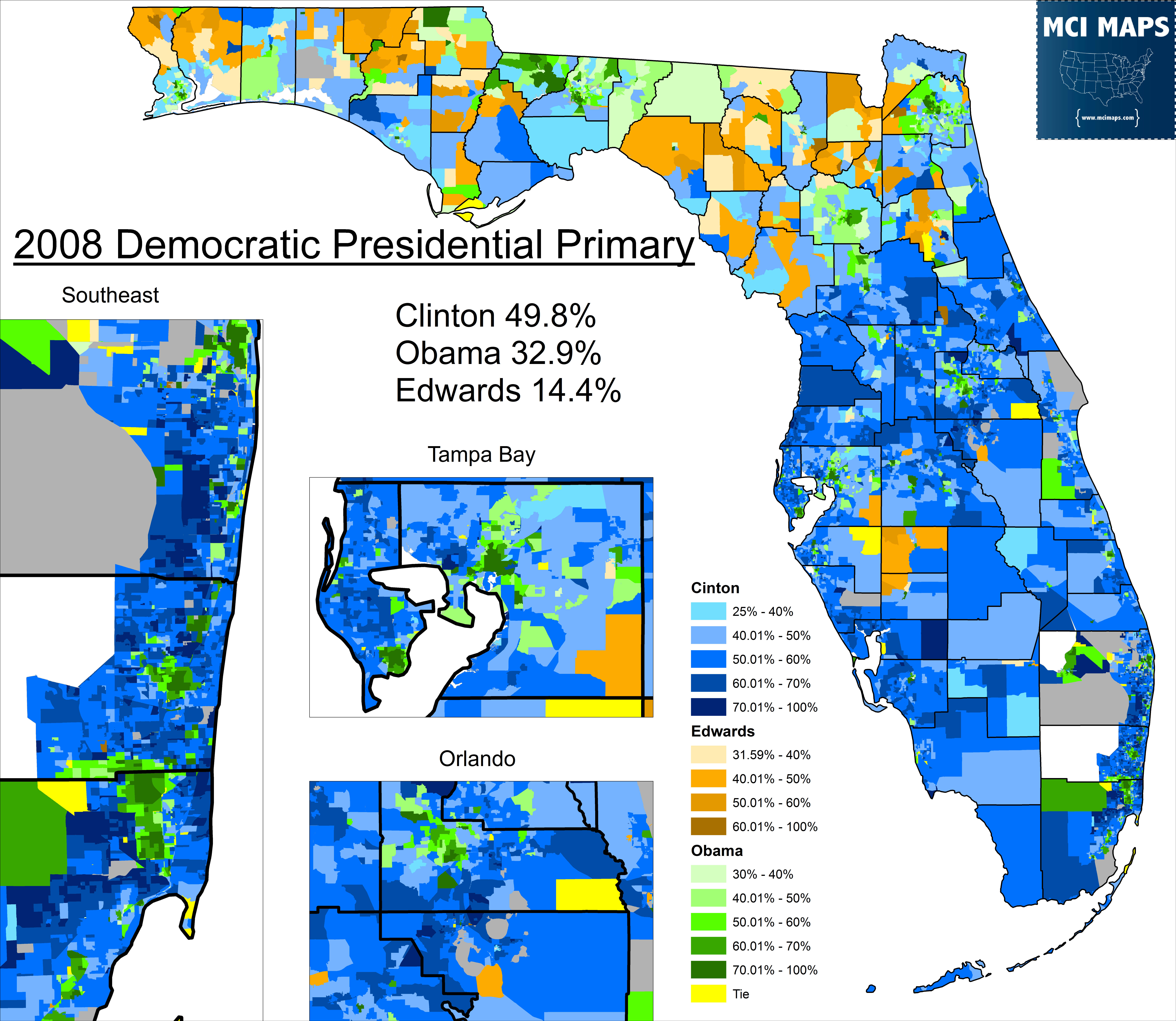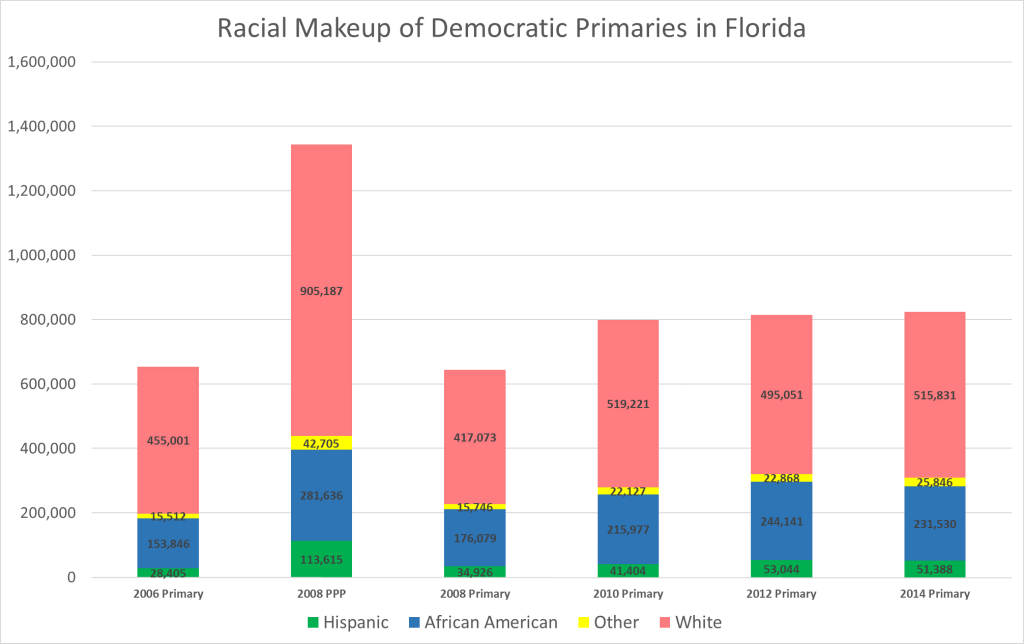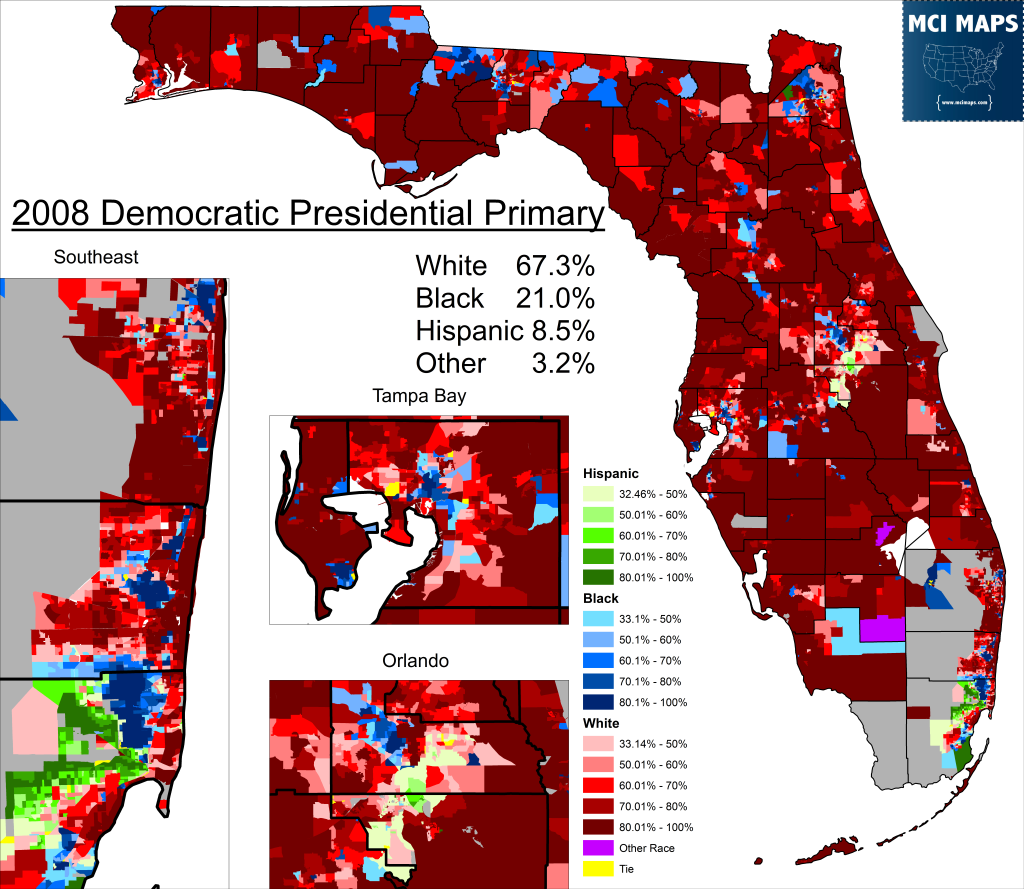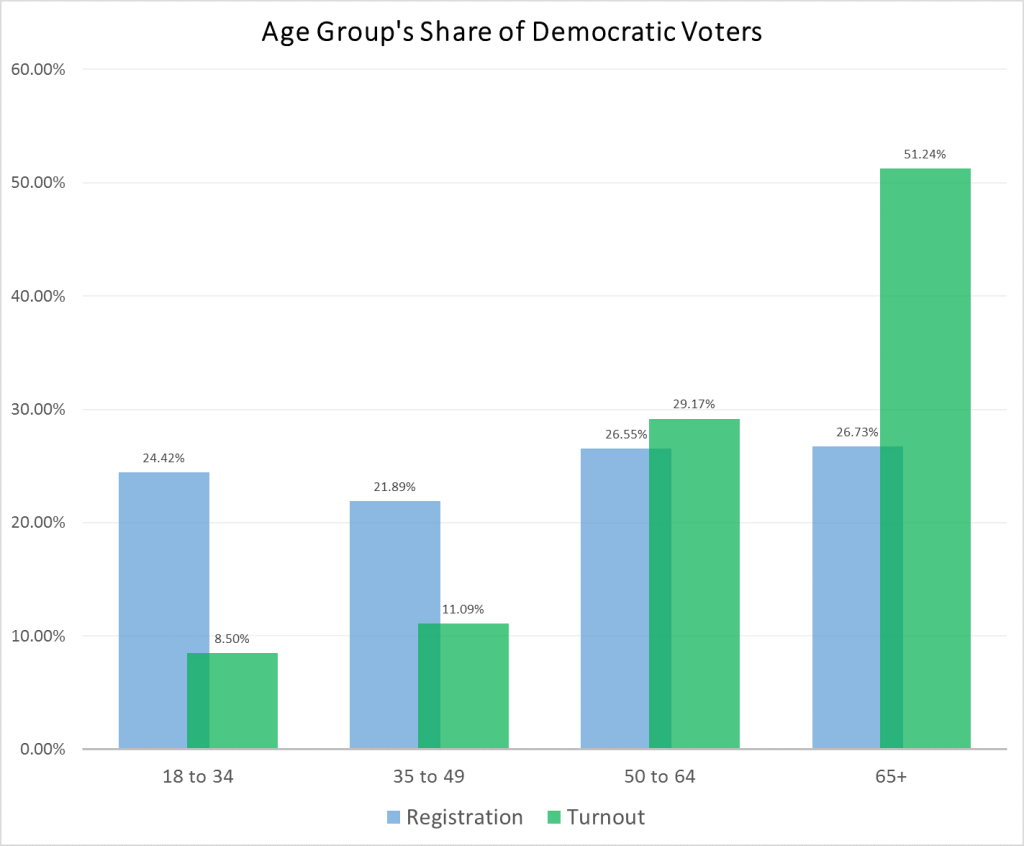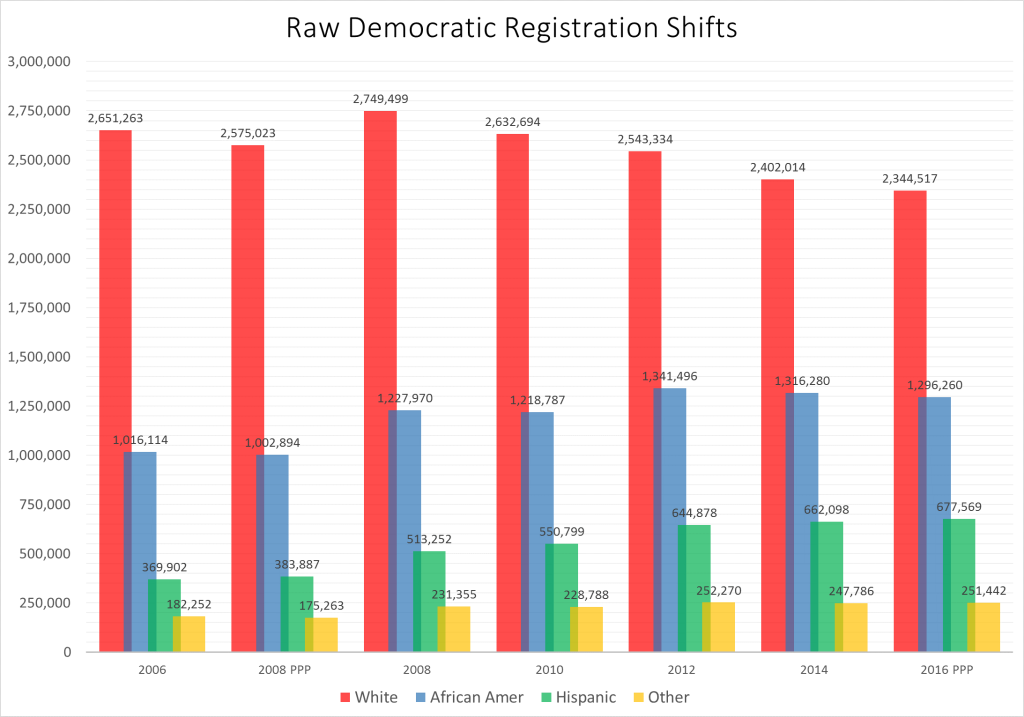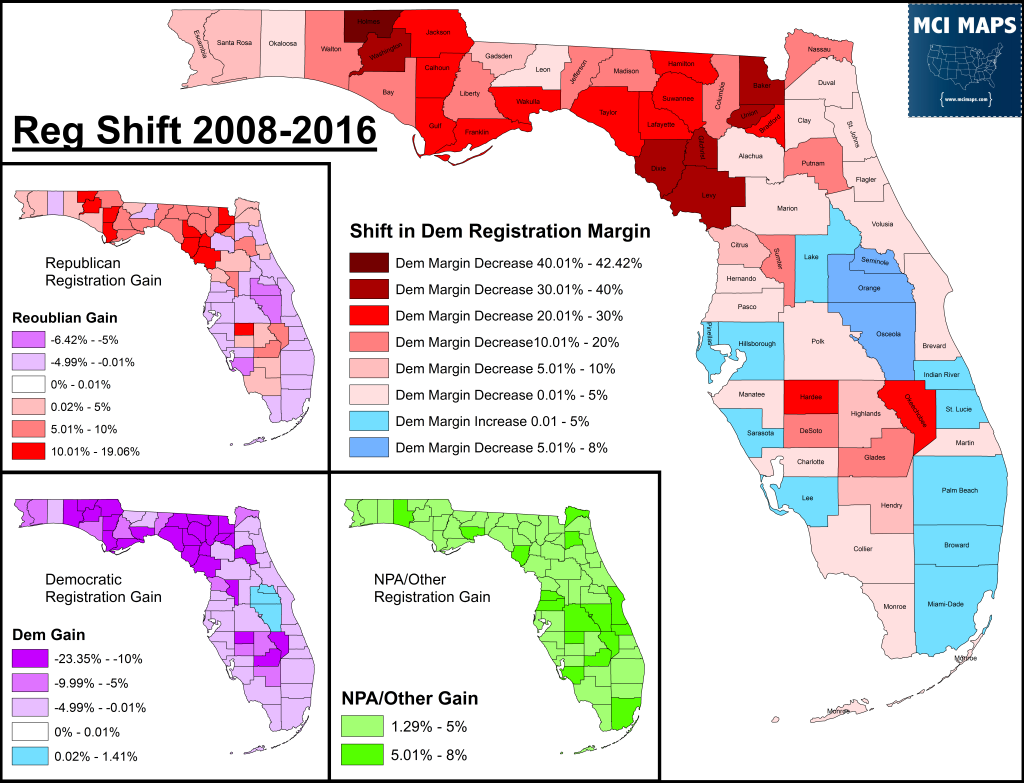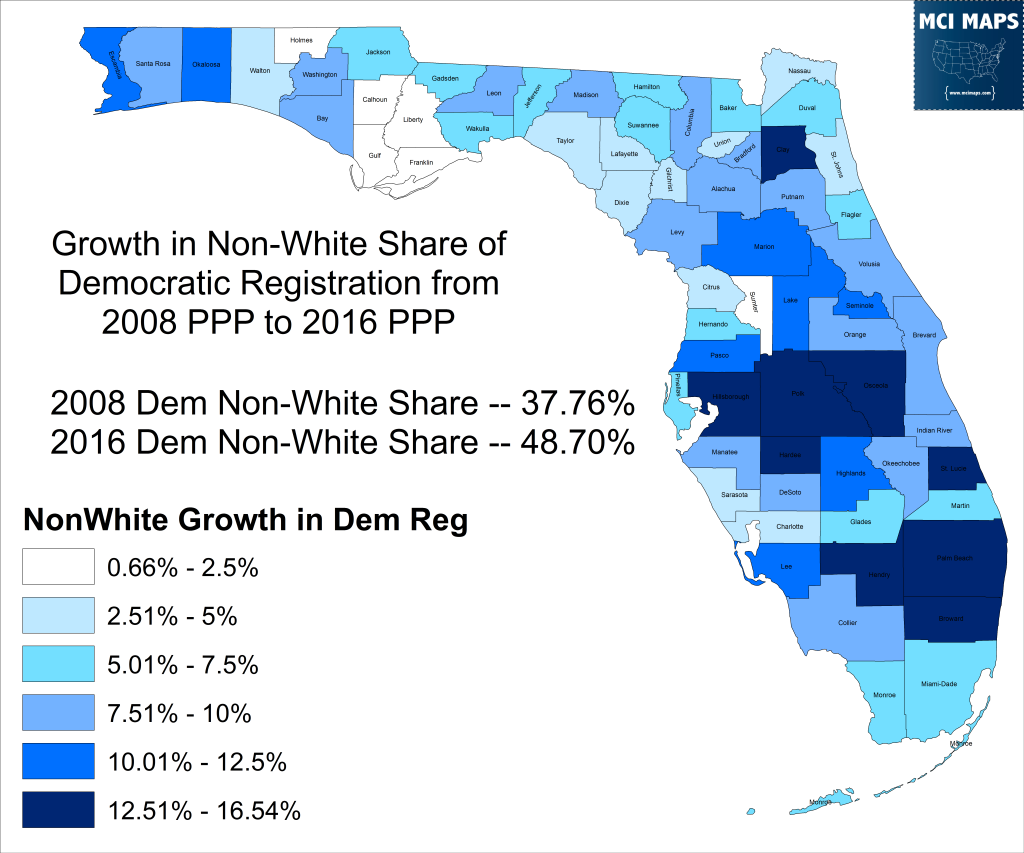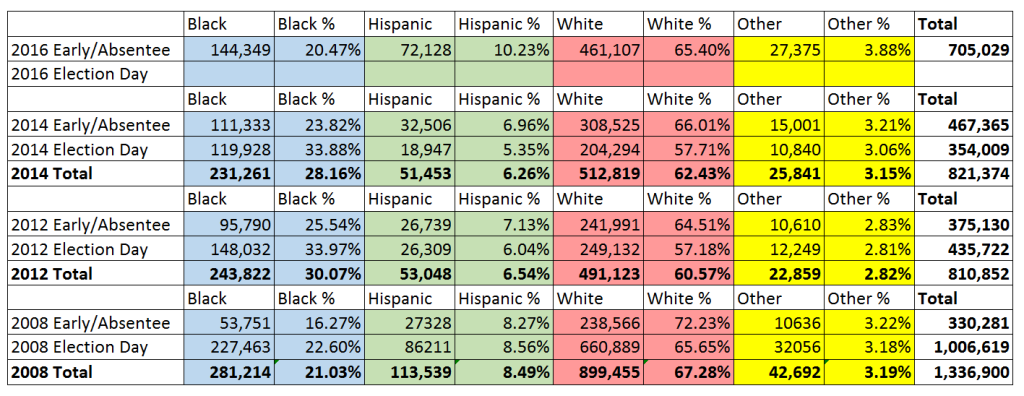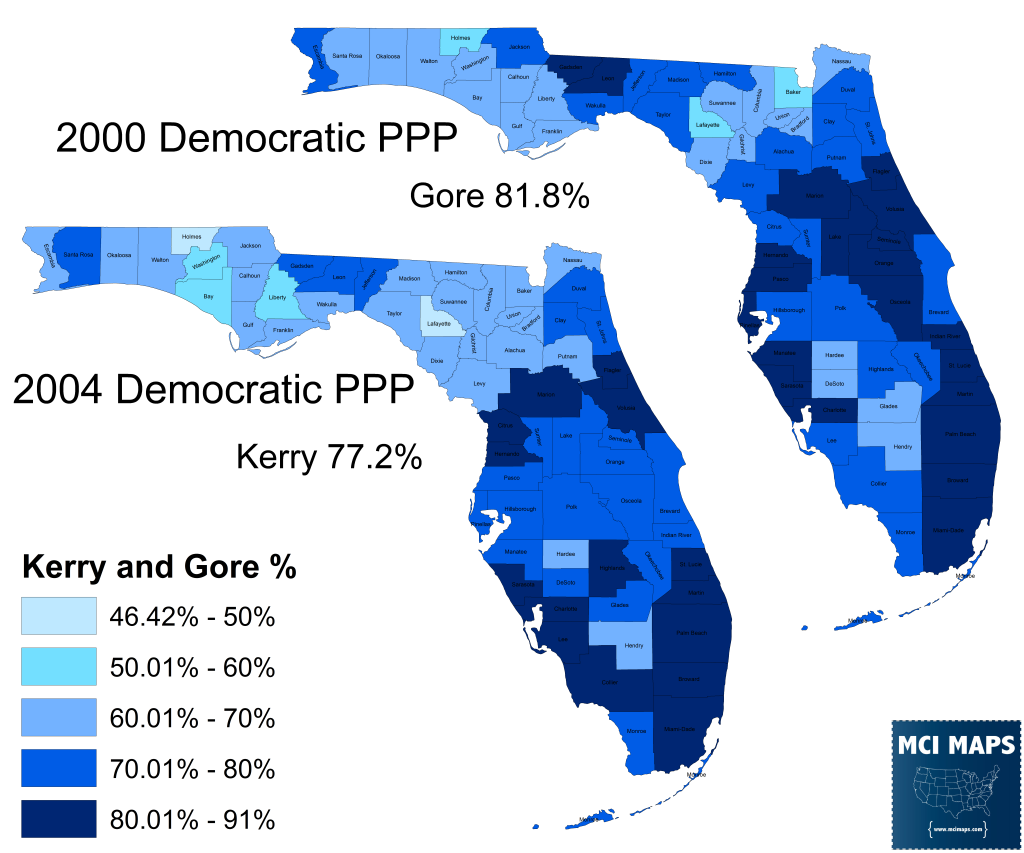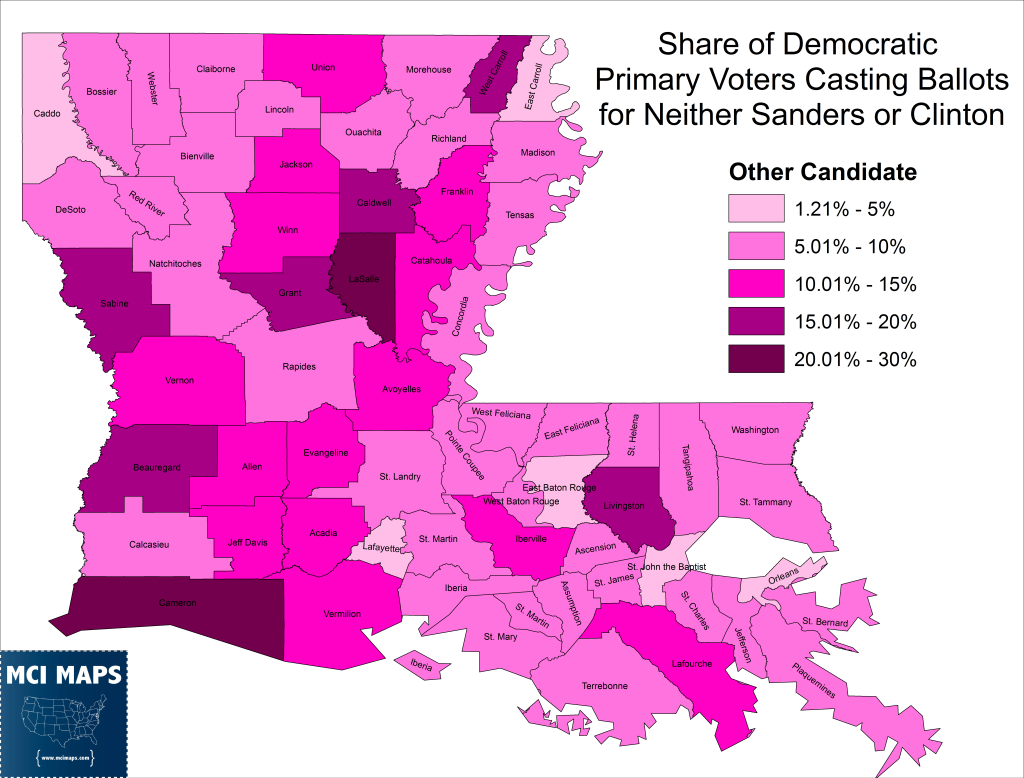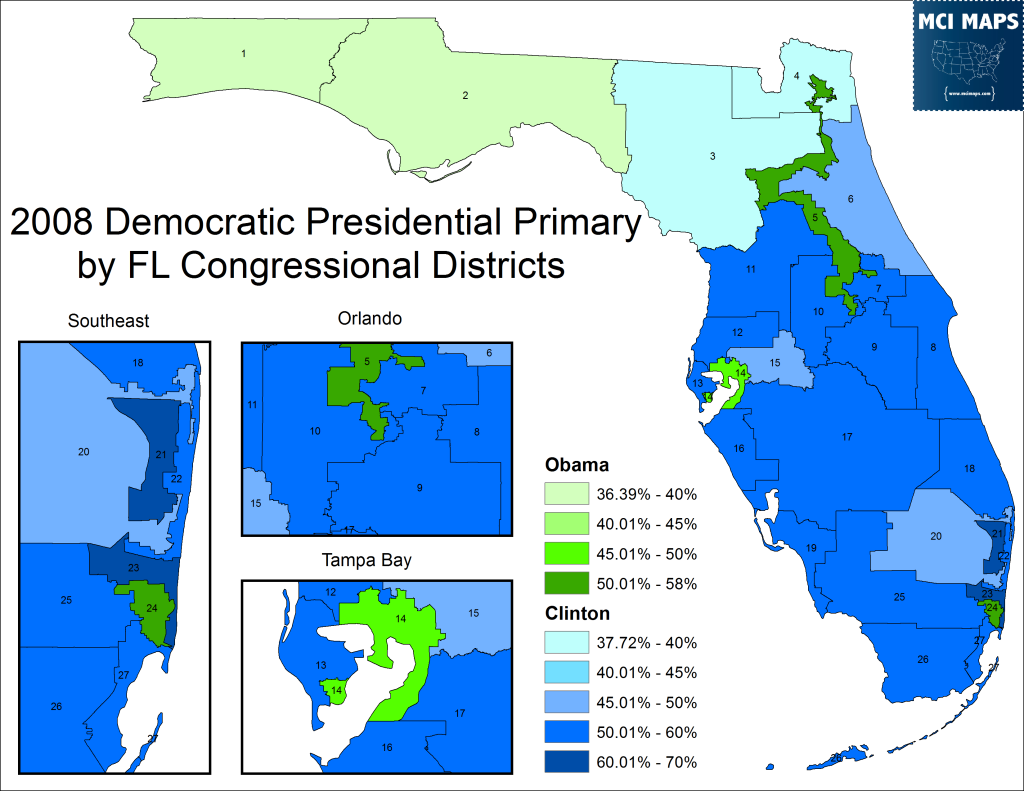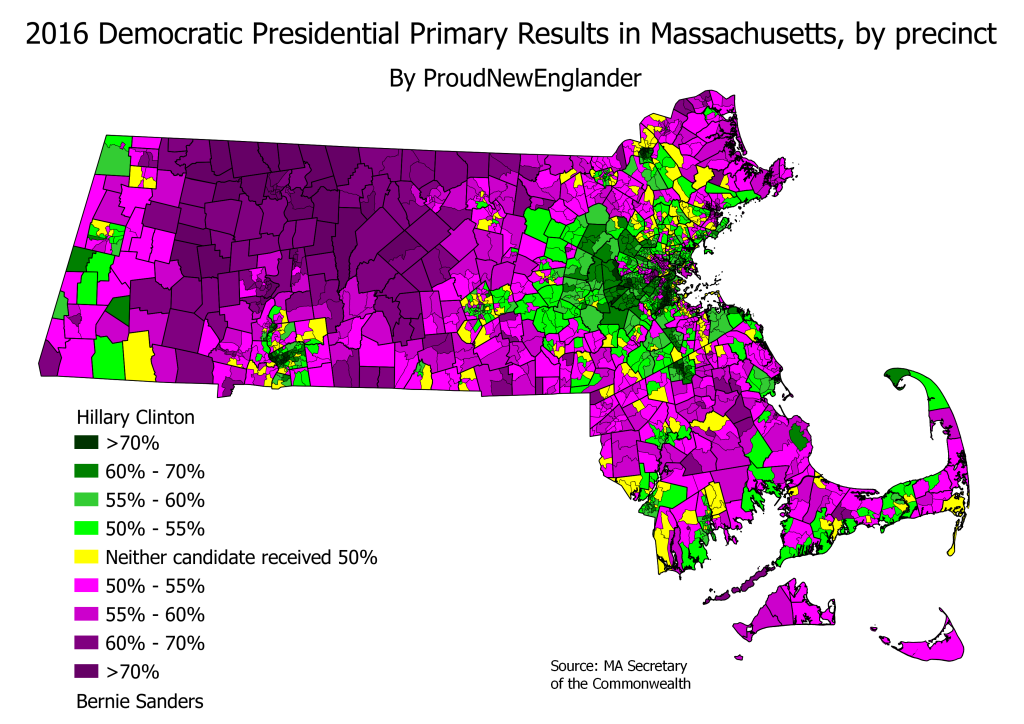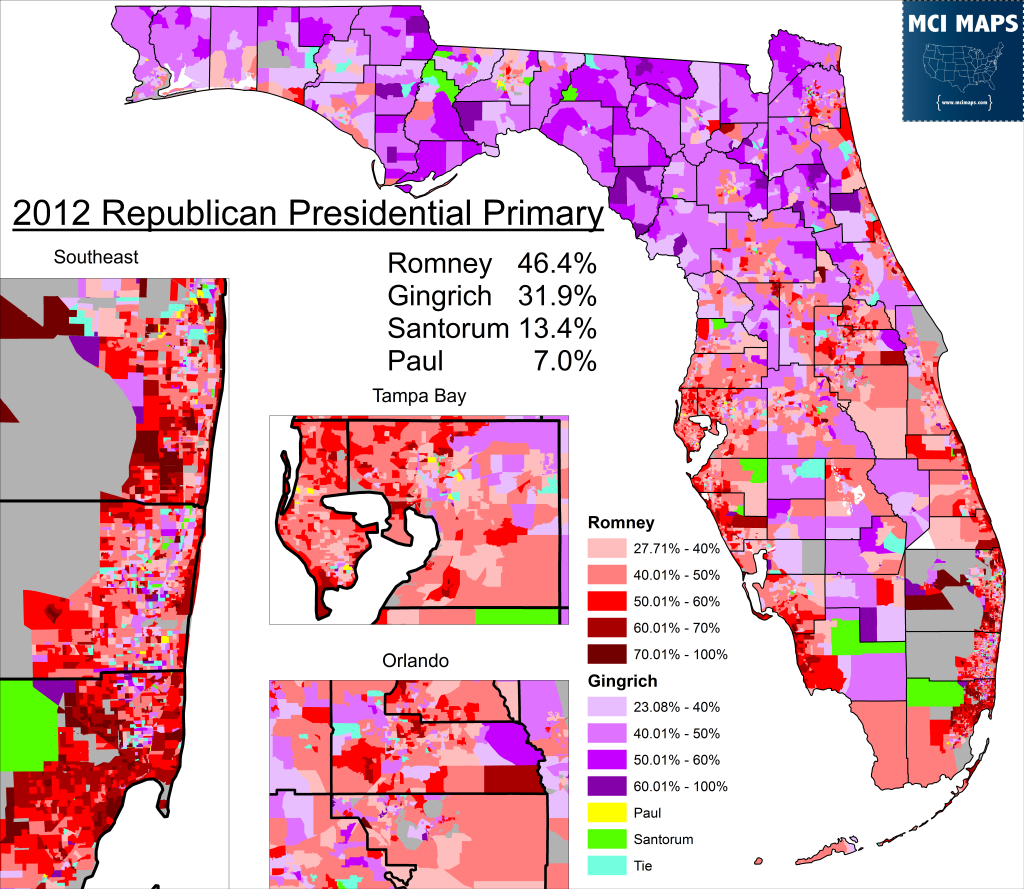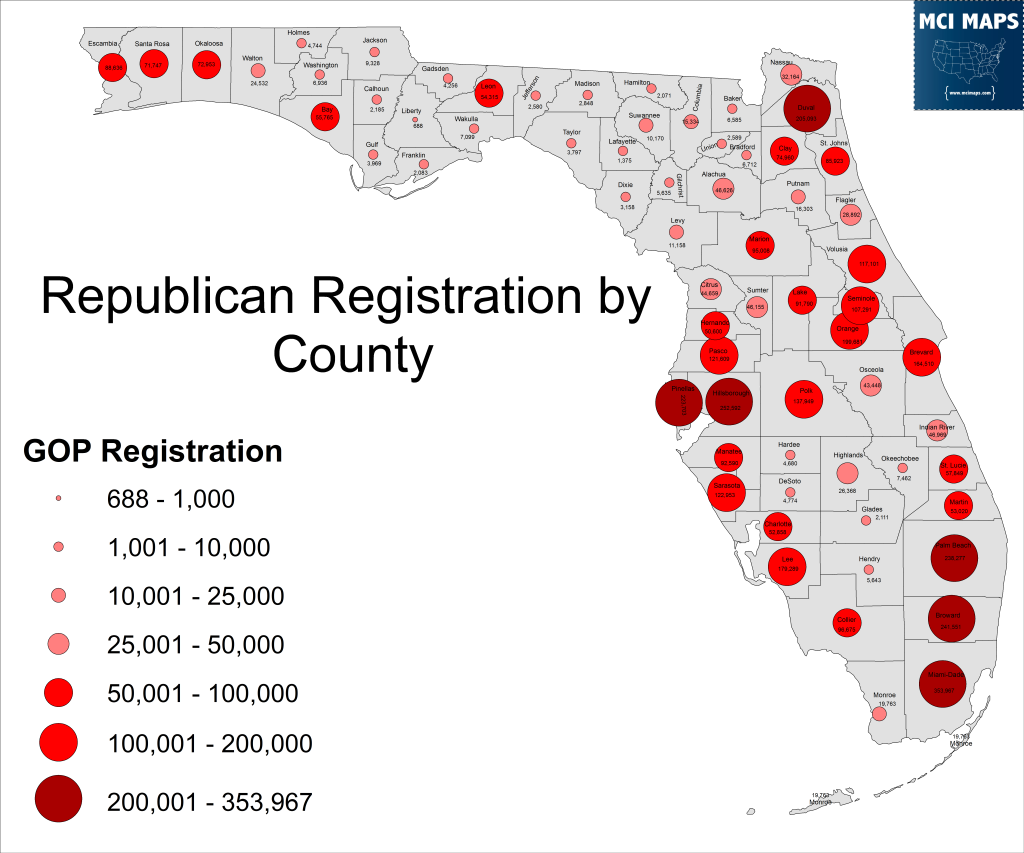Florida’s presidential primary is right around the corner. This article will look at both primaries as Trump tries to knock Rubio out in his home state and Clinton aims to rack up a big win to secure her delegate lead.
Democratic Primary
Hillary Clinton is the presumptive favorite to win the Democratic nomination and win the Florida primary. Sanders kept his campaign alive with an upset win in Michigan, and is poised to win additional states with his coalition if young voters and working class whites. However, Florida polls show no evidence of a tightening between Clinton and Sanders, with the former Secretary of State maintaining a 30% margin in the polls. Clinton benefits from Florida’s racially diverse electorate, with non-white voters still remaining as her strongest group. Clinton also benefits from the electorate generally being older. When Clinton beat Obama in Florida in 2008, she won by dominating among suburban Democrats and Hispanics. Obama, meanwhile, won college towns, doing well in liberal suburbs, and African-American neighborhoods, and John Edwards carried conservative white rural Democrats. Now, the 2008 primary was a unique situation. The state had moved the primary early, resulting in delegates being taken away and a DNC ban on candidates campaigning there. However, that does not mean the 2008 primary isn’t worth looking at. Turnout was a record high for that primary, with more Democrats casting ballots that January than they have in any of the normal August primaries for federal, state, and local offices.
Despite the candidate ban, the Democrats of Florida were well in tune with what was going on in the primary. By this point, post-Obama winning Iowa and just after South Carolina, anyone who watched the news or went online knew about the candidates running. The precinct results give credence to the notion that Floridians made an informed choice. The precinct map below reflects each candidate winning the groups they were strongest with. Also, even if the ban had not been in place, and with Super Tuesday a week away, it is unclear if Obama would have put millions into the state. The campaign would likely have focused on turnout operations to rack up delegates in key congressional districts. Clinton still would have won, but maybe not by as much.
For caparison, here is the racial makeup of the 2008 primary by precinct (though note the precinct boundaries in this map have been updated)
Obama’s wins closely mirrored African-American areas and white suburbs in liberal areas like Tallahassee and Gainesville. Clinton, meanwhile, won the Hispanic region in Orlando (more Puerto Rican) and in Miami-Dade (more Cuban and South American), in addition to the vast majority of white cities and suburbs. John Edwards won the overwhelmingly white, conservative Democrats of North Florida that often cast ballots for Republicans in the fall. Edwards’ campaign was already on its death legs by this point.
For Clinton, polling this time around shows her dominating with African-Americans and holding healthy leads with Hispanics. Sanders has been pushing for Hispanic voters. A notable question is if the Cuban and Puerto Rican vote will differ in their candidate choice. Clinton did very well with white Democrats that live in the cities and suburbs. Clinton maintains leads with white voters in Florida and if she is able to maintain strong support in the suburbs, she will win comfortably. Sanders, meanwhile, will no doubt hope to win liberal white suburbanites in areas like Tallahassee, Jacksonville, and Gainesville. However, if the white Democratic vote remains older, then Clinton will win the cities as well.
Age
Age is an important factor in determining how Sanders will do in Florida. The state is known for its older population. However, it should be noted 24% of the registered Democrats in the state are under 35. However, the problem for Sanders is that with early/mail voting so far, those under 35 only make up 8.5% of the Democratic primary.
For Sanders, the campaign must count on a major youth turnout surge for early voting or election day. Right now, under 35 make up 10% of the Democrats voting early (excluding mail). The youth vote should rise as mail voting (which skews older) wraps up. One benefit for Sanders is spring break was last week and many students are more likely to vote on election day as a result.
Race
Another factor in determining the margin in Florida will be the non-white share of the Democratic primary. For Clinton, the larger the non-white share of the primary, the better for her. Democratic registration figures have seen some major demographic changes in the last ten years, with the white share falling from 62% to 51%.
There has been a marginal increase in African-American share and a bigger bump in the Hispanic share.
When looking at it from a raw votes perspective, the number of white Democrats has been falling since 2008, Hispanics have consistently grown, and African-Americans have been up and down.
There is a lot that can be said about the drop in white Democrats. Many of the losses come in the largest counties, where both parties are ceding ground to independent voters. Looking at both parties, Democrats have lost the most voters (as a share of each county) in the conservative panhandle, while Republicans have lost ground in the central and southern part of the state. Democrats have managed to improve relative to the GOP in major counties. The graph below shows three maps, one for each groups’ share of the county and how it has shifted since 2008. The main map shows how the margin (or gap) between the two parties has moved in the last eight years. Note, an improved margin does not mean either party controls the county, it simply means they have improved by either widening the gap (if they already were ahead in registration) or narrowing it (if they trailed).
The panhandle of Florida has been growing more Republican in registration for decades. Outside the Tallahassee metro area, the region votes solidly Republican despite being heavily Democratic in registration historically. However, Republicans continue to improve in registration. This graph below blew up on my twitter feed for showing the Republican increases just since 2014.
Many Trump fans saw this as evidence that GOPers were switching parties to vote for Trump. However, many of these shifts are part of the natural flow of the district. In the top 5 counties for GOP growth as a share of the registration (Holmes, Dixie, Washington, Calhoun, Taylor), Dems switching to GOP never accounted for more than 48% of the GOP growth, and it was as low as 35%, while NPAs to GOP was less than 10% of the growth in those counties. Much of the shift was simply new people registering to the GOP as older Democrats moved or passed away or became inactive. The region has been Democratic out of history and tradition despite voting heavily Republican. But as new generations rise and older ones pass on, the registration catches up with the voting behavior.
So why am I talking about party registration shifts? Because it affects the Democratic primary. As more white Democrats decrease, the more diverse the primary is likely to be. The map below shows the non-white share of registered Democrats from 2008 and 2016.
The biggest increases have been in Central and South Florida, with large counties like Broward, Palm Beach, Osceola, and Hillsborough seeing big shifts. The shift in the panhandle is iffy because in several counties the non-white vote was so small that even white Democrats reducing in the region didn’t yield a much greater non-white share. Likewise, counties with the largest gains already had significant non-white populations. Not a single county saw a reduction in the non-white share of Democratic registration.
Now while the Democratic voters have gotten more diverse, how each group turns out will affect their share of the vote. While white voters only make up 51% of the Democratic party in Florida, they made up 62% of the primary in 2014 thanks to lagging turnout among non-whites, especially Hispanics. The graph below shows the racial composition of major primaries over the last ten years.
While the primaries have slowly grown less white, it is still nothing compared to the registration shift shown earlier. Hispanics fall well below their share of registration, peaking in the 2008 primary at 8%.
Looking at the current turnout among early and absentee voters, the Democratic primary is on pace to be more diverse than recent primaries. 65% of current ballots cast are white, below the 67% white share of the 2008 primary. In addition, history shows the election day vote in Democratic primaries in Florida is less white than the early/absentee figures.
The Hispanic share of the vote is notably up, with more Hispanics voting already than they did in the 2012 or 2014 state/federal primaries. Assuming strong election day turnout, Florida will likely see more than the 1.3 million who cast ballots in 2008. There are currently 600,000 Democrats who cast ballots in the 2012 or 2014 primaries that have not yet voted in this contest.
When it comes to absentee/mail voting, there is more room for non-whites to grow if a large share turns their ballots in before Tuesday. 55% of whites have turned their ballots in, while it is 51% for Hispanics and 48% for African-Americans.
Panhandle
One wild card I will be watching Tuesday is the panhandle vote in the Democratic primary. The 2008 precinct map showed Edwards doing well in North Florida. The conservative Democrats of the region preferred him over Obama or Clinton, despite Edwards’ chances being virtually over by that point. How these conservative Democrats vote this time is up in the air. Clinton has done better with Southern whites than Northern whites, but she nor her husband were especially popular in the region. The area is known for protest votes against well-known Democrats (link). In the normal August primaries, there is often a notable undervote, as these conservative Democrats show up to vote for local offices and leave primaries for Governor or Senate blank. However, in this March primary there is only the Presidential ballot. It is possible turnout will drop in the region, but the small rural counties are known for very high turnout rates. What is more likely is a notable chunk of the panhandle vote could go to neither Clinton or Sanders.
In 2000 and 2004, after the Democratic nominations were sewn up, the weakest shares for Kerry and Gore were in the panhandle.
This phenomenon was also seen in Louisiana last week between Clinton and Sanders
The Proportional Rules
While Clinton is likely to win Florida, the margin will matter due to the Democratic Primary allocating delegates by Congressional District. Each candidate gets delegates that are proportionally allocated based on the margins in each district. For Clinton, the goal is to rack up as massive a delegate lead as possible by scoring major wins in Congressional Districts. In 2008, Clinton won 22 of the 27 districts.
The chart below shows candidate percentages and the racial makeup of the turnout.
Obama won districts with large shares of the vote being non-white and in North Florida also benefited from Edwards taking large shares of conservative whites that would not have backed Obama otherwise. Clinton has solid wins in most of the districts south of Gainesville thanks to her support among suburban and older whites. Her strength with Hispanics pushed her just shy of 60% in the 25th and 9th, and her best showing was the 21st, a suburban district in Boca with many retirees and a large Jewish population. Clinton’s second best district was the 23rd, home to Debbie Wasserman Shultz, who has angered Sanders fans for her seeming backing of Clinton. Clinton also managed to win the 20th, which was majority African-American due to dominance with whites in the suburbs and not getting crushed with black voters.
Clinton will no doubt be aiming to get solid wins in the counties dominated by the suburbs in Tampa, Orlando, and Southeast Florida. Many of the Democrats in these regions are middle/upper class, liberal but not as active, commuters. These voters are similar to many who lived in the Boston Suburbs, a region Clinton won in the Massachusetts primary, which made up for her heavy losses in the working-class west.
This amazing map by ProudNewEnglander also highlights Clinton’s suburban strength
Clinton’s solid wins in the Virginia suburbs also show her strength with suburban Democrats, who will be even older in Florida.
Sanders has no clear best district. North Florida districts will see a significant African-American vote, not to mention Clinton has done well with whites in the south, much better than in the north. Clinton’s dominance with the media markets surrounding North Florida also bode well for Clinton in the North. It will be interesting to see how Sanders, who is Jewish, will do in the Palm Beach and Broward regions. Meanwhile, Sanders’ best areas may be in the upper-middle parts of the state like the 6th, 11th, 3rd, 17th, and 10th. How the conservative working class whites of North Florida vote (more like Michigan or more like Georgia) will determine Sanders’ margins. If he does lose the state by 15 points or so, he could lose every district.
Conclusion
While the polling debacle in Michigan should give everyone pause when blindly believing polls, Florida is different. A state like Michigan always made sense as a strong Sanders state, but polling got it wrong. Florida, meanwhile, with its diverse electorate, older white population, and large suburban Democrat population, is a prime state for Clinton. For Sanders, the goal will be minimizing delegate losses.
Republican Primary
The Republican Primary is primarily a two-way race between Donald Trump and Senator Marco Rubio. Trump’s lead in the polls, ranging from 6% to 23% in the last few weeks, makes him the favorite to win. Rubio’s failure to win his home state would doom his presidential chances, which already are on life support. Trump’s lead hovers around the high 30s and low 40s, which would be a win with Cruz and Kasich still taking votes.
For Rubio and Trump, there are clear paths to victory, and key regions both must do well in. Trump dominates the polls with white voters and he and Cruz both do well with conservative and evangelicals. Rubio’s best showings have been with moderates and voters centered in cities and suburbs. The suburban vs rural Republican split in Florida played itself out 4 years ago with Gingrich vs Romney. In that primary, Romney won the state with his better organized campaign and by spending far more money than Gingrich. However, Gingrich still won 34 of 67 counties, almost all rural/conservative. Romney, meanwhile, won suburbs and cities.
The precinct map below further highlights the split. Gingrich dominates in the rural counties, winning a vast majority of precincts. However, precincts around big cities (including northern ones like Tallahassee and Jacksonville) backed Romney, and further south the map is a sea of red.
Gingrich won more counties, but still lost by double digits. This is because the counties he won had far fewer Republicans, providing smaller win margins in terms of raw votes. Romney, meanwhile, racked up huge vote leads thanks to the larger populations in his counties.
This provides a warning for Trump. The front-runner has done well with conservative and rural voters, but in Florida they are outnumbered by suburban and city Republicans. North Florida itself was only 20% of the primary in 2012. Even if turnout increases, it won’t move the needle that much for small counties. However, Trump’s advantage is that if he simply follows the Gingrich path with a mid-30s showing he would likely win.
For Rubio, his goal must be to follow a similar path to Romney, winning big in the suburban counties that have lots of Republican votes. Southeast Florida and the western coast are key territories for Rubio. The west coast counties, littered with upper income suburban Republicans, are not the group Trump has always done best with due to his rhetoric. Many of these suburbanites are moderate conservatives. Rubio must rack up big wins there, in Miami, Tampa Bay, and Orlando.
Trump’s record in suburbs is mixed. He did respectably in the Detroit suburbs in the Michigan primary. However, the state’s economic troubles give a candidate like Trump plenty of ammo for his angry rhetoric. Meanwhile, the DC suburbs of Virginia rejected him handily, and he under-performed (but largely won thanks to a split field) the Boston suburbs compared to his statewide win. One thing is for sure, if Lee, Sarasota, or Collier County come in with weak Rubio wins or even a Trump win, then the night will go very bad for the Florida Senator. On the other hand, Trump does not need to do well in those suburbs and just needs the rural counties to pull out a mid-30s win (assuming the suburbs don’t represent a larger share of the vote than they did in 2012). Early voting right now shows counties less loyal to Trump, like Dade, with a higher share of the vote than in 2012. However, this could change with election day. It is too soon to say.
Cruz Spoiler
If the vote between Rubio and Trump is close, Cruz could be a key spoiler here. Of course, John Kasich is likely to take the most votes from Rubio, but Cruz’s impact is not as clear cut. Cruz of course will do well with rural, conservative, evangelical voters, a group Trump needs to run up the score with. However, Cruz is also Cuban and has been campaigning in Miami. Cruz could well take some votes from both sides.
Race
Another important ingredient for Rubio is a dominating Hispanic showing and strong Hispanic turnout. Hispanics are the largest non-white group in the GOP primary and Rubio must get them to turn out in force to win. Most Florida GOP Hispanics are concentrated in Dade, Rubio’s home county. Right now, Hispanics make up 10.8% of the GOP vote in early/mail ballots, but are 11.2% of registration. Worse off for Rubio, just a few days ago Hispanics where 12.3% of votes cast. In 2012, the GOP share was only 7.8% of the vote, so the current 10.8% is an improvement. However, the 2012 early vote was 9.3% Hispanic and fell due to a low election day share.
There is no guarantee this will happen again, especially with turnout up all around. However, Rubio needs the Hispanic share to hold or increase, not fall. For Rubio, a strong election day turnout among Hispanics, and Dade county in general, is vital.
Conclusion
The GOP primary is likely to result in a Trump win. Rubio is often placed in distant second and in some polls has found himself close to Cruz. Rubio’s only chance is to defy the polls with turnout in suburbs that show up to reject Trump (and stick with Rubio, not Kasich). Rubio would also need Cruz, who is doing well right now, to take more rural voters from Trump than he takes Hispanics from Rubio. Rubio is relying on a lot of luck and a ground operation that doesn’t seem to be there. If I was a betting man, I’d be all in on Trump, though I wouldn’t be surprised if there are shades of similarities to the 2012 map.

